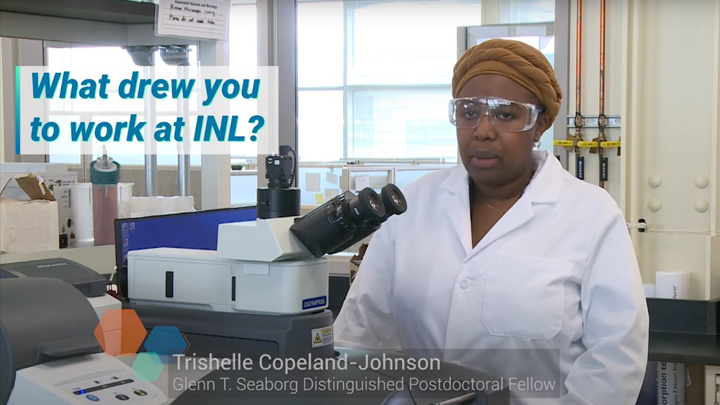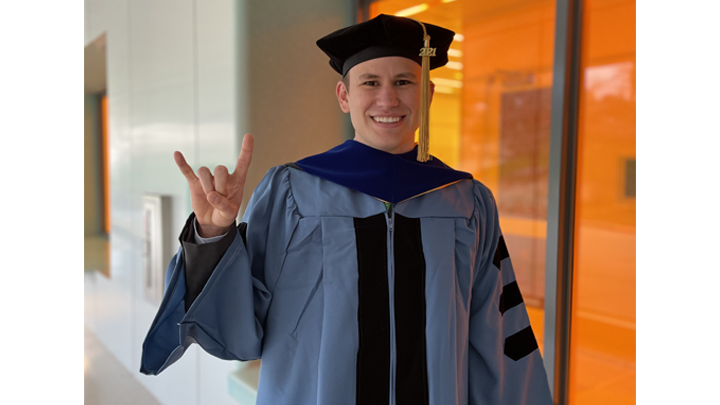College of Engineering News Room
USF alums Trishelle Copeland-Johnson and Christopher Allemang advancing their fields at Department of Energy-contracted national labs
by Russell Nay

As a Glenn T. Seaborg Distinguished Postdoctoral Fellow at Idaho National Laboratory, USF chemical engineering alum Trishelle Copeland-Johnson researches the corrosion mechanisms of materials used in creating clean energy of the future.
“The Glenn T. Seaborg Institute is one of three in the DOE National Laboratory Complex specializing in research on the Actinide series of the periodic table, which have significant impact in nuclear energy,” Copeland Johnson said.
Her current research at the lab is an original project of her own, involving the search for better materials to use in the construction of nuclear reactors — specifically molten chloride salt fast reactors. A current challenge faced by nuclear power plants with this reactor type is that the materials traditionally used in these reactors suffer a relatively high rate of corrosion.
Nuclear energy, by nature, is created under harsh conditions that include high temperatures, extreme pressure, and radiation over long periods of time. The damage caused by corrosion and environmental stressors determines the lifetime of a nuclear reactor. Corrosion in nuclear reactors has caused failures in nuclear power plants since the 1970’s, costing the nuclear power industry billions. Longer-lasting materials potentially discovered by Copeland-Johnson’s research could change the current efficacy these plants.
“The coolest part of my job is that I get to work with materials that you can’t necessarily research in other facilities, like plutonium, uranium — and looking at them in applications where we require a lot of intricate infrastructure and support and expertise in order to conduct this type of work,” she said in a recent Idaho National Laboratory-produced video interview.
While she’s completed degrees and conducted research across multiple engineering fields, the milestones of Copeland-Johnson’s career can be connected by an overarching goal — the advancement of clean energy.
“A majority of my research has been focused on clean energy, initially in photovoltaics to current nuclear,” she said. “That aligns with my original research interest in alternative energies for environmental sustainability since I started my career journey.”
Copeland-Johnson’s academic research career began at the Seminole State College of Florida where she applied for the U.S. Department of Energy Community College Internships program and spent a semester interning at a DOE national lab. She published her first peer-reviewed journal article during an internship she got two years later at Ames National Laboratory through another DOE internship program while completing her undergraduate degree at USF. She said that this experience reinforced her decision to pursue a career in research and development.
Copeland-Johnson was also a member of the American Institute of Chemical Engineers chapter at USF, which helped her enhance her leadership capabilities. This prompted her to found the National Organization of Black Chemists and Chemical Engineers USF chapter, and her involvement with the organization spans from before enrollment at USF through her master’s and PhD. She’s currently the organization’s communications national planning sub-committee co-chair.
She said that starting the USF NOBCChE chapter was a way for her to extend the same opportunities and professional development she had by being involved with the organization to other students underrepresented in STEM fields.
“Being Black in the sciences and engineering disciplines is an isolating experience that can take a toll on one’s mental health,” Copeland-Johnson said. “Having a group of individuals to reach out to for support and having the solidarity in a community of individuals with similar backgrounds is critical.”
Completing her master’s at the University of Delaware led her to reshape the focus of her PhD, as her graduate research experiences made her realize that her academic interests were vested more in materials science and engineering. Her initial attraction to chemical engineering came from its interdisciplinary nature and diverse applications, but as she continued her studies, it became apparent that many of the field’s research areas tend to funnel into highly specialized subjects. She also realized that the majority of her past internships had aligned with material science and that she enjoyed interacting with individuals from physics, chemistry, and various other science and engineering disciplines to solve complex, interdisciplinary problems.
As a doctoral student at Iowa State University, Copeland-Johnson was awarded a GEM fellowship sponsored by Brookhaven National Laboratory, so much of her doctoral research was conducted there. Her work included disaster-based research on the explosions at the Fukushima Daiichi Power Plant in 2011, and she contributed to the development of a new class of materials for nuclear reactor fuel rods that would strengthen their ability to withstand emergency conditions and give plant operators more time to restore normal operations.
Before finishing her PhD, Copeland-Johnson was offered a position at Idaho National Laboratory and began work there in February.

At Sandia National Laboratory, USF electrical engineering alum Christopher Allemang develops small objects with big impacts. His work in the field of microelectronic device fabrication involves creating solid-state electronic components that exist on a near-infinitesimal scale, ranging in size from several nanometers to several atoms.
The applications of microelectronics are extensive. During his PhD, Allemang focused on research involving thin-film electronics, which have uses in everything from textiles and wearable electronics to digital displays and solar cells.
Currently, Allemang is a member of a hardware team working on a $6 million 3-year project, recently awarded by the U.S. Department of Energy, to study brain-inspired computing. This project — a codesign collaboration between Sandia, Oak Ridge National Laboratory, New York University, the University of Texas at Austin, and Temple University in Philadelphia — hopes to mimic the brain to create probabilistic computing to answer questions, like a coin toss, that intrinsically have some degree of randomness.
Allemang’s position at Sandia National Laboratories began with his interest in research, which he discovered during his undergraduate at USF. Doing undergraduate research, Allemang was able to gain experience that built a “strong foundation to become a better researcher” during his PhD. Together with his experience with the USF Institute of Electrical and Electronics Engineers chapter, as sequential treasurer and chair, he built roots in leadership and collaboration, as well as connections with the broader IEEE professional society where he found opportunities to network with professionals in the field.
“Just by participating throughout my undergraduate, I was starting to become my own researcher by experimenting and sharing my results,” Allemang said. “Doing undergraduate research is what made me decide that I wanted to do a PhD because I really enjoyed research, and I thought that doing a PhD would be the only way to continue to do research.”
The courses he encountered on semiconductor materials and devices during his undergrad were especially interesting, and he looked to apply for a graduate program at top universities with professors conducting research in the fields.
Ultimately, he chose University of Michigan for its research facilities, compatibility with the professor he’d be conducting research with and the university’s available financial support. He credits his academically successful transition from USF to his graduate program at the University of Michigan to the support group he built after moving.
“I think the hardest part for anyone going someplace new is feeling like you’re alone in your program or the only one finding a course difficult,” Allemang said. “After building a study group with a few friends, I ended up getting a really strong support network that made it possible to finish my PhD there.”
He also supported his peers at the university by serving on the College of Engineering’s Diversity, Equity, and Inclusion Student Advisory Board. Created in 2016 as part of the university president’s five-year plan to achieve the university’s vision for diversity, equity and inclusion across each school, college and unit, the board publicly released a climate study as part of its yearly strategic plans that advised college administration of specific actions and initiatives that should be pursued to advance diversity, equity and inclusion within the engineering community.
Its success led the board to provide feedback to other colleges on conducting climate surveys with their own students.
“Just conducting climate surveys to open others’ eyes is really helpful,” Allemang said. “Even if things aren’t happening in Ann Arbor, students could still feel unsafe on campus — especially considering the backdrop of a new administration and people rallying in Charlottesville for white supremacy at the time. A lot of people who have the privilege to feel safe might not have known other students felt unsafe.”
Allemang was awarded a PhD fellowship from the IEEE Electron Devices Society in 2020 for his research on customizable scalable manufacturing of thin-film electronics. Annually, only three of the fellowships are awarded to students who demonstrate their ability to perform independent research in the fields of electron devices and have a proven history of academic excellence.
While he said he may pursue academic research opportunities with university professors or by getting a tenure track position in the future, he said wanted to experience different research environments by working at a national lab and hopes to turn his current postdoc position into a full-time staff scientist role.